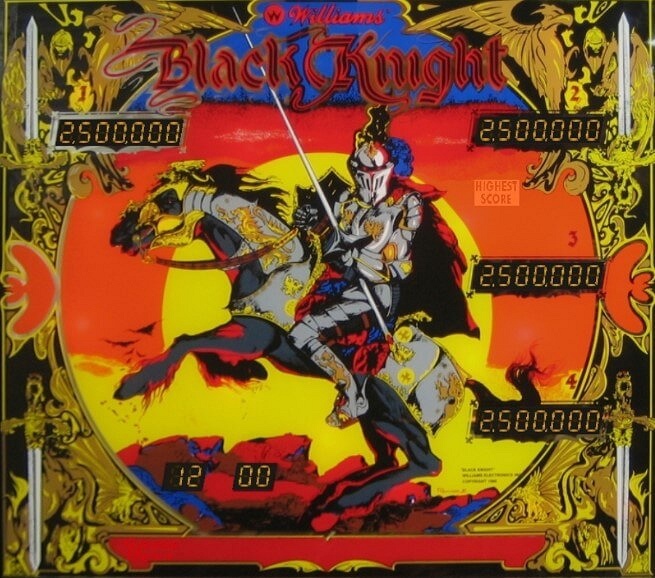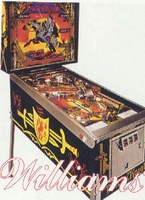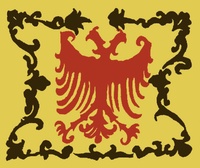

Black Knight
For several Williams games (especially before 1987), Speech Processing was a separate task than Software Programming and may have been done by a different person than whom we list as having done the Software. Paul Dussault did the English Speech Processing for this game. Black Knight' introduced 'Magna-Save' and the Bonus Ball concept where the player with the highest score won additional seconds of free play. Magna-Save was a feature where a user could press a button on either side and magnets would prevent the ball from draining via that outlane. It would stop and hold the ball and drop it into the inlane. The user had to perform some task to re-enable magnasave. Steve Ritchie confirmed his voice was used on this game. Comments from designer Steve Ritchie:Black Knight was the first game ever to employ faceted inserts (the transparent inlaid plastic windows) in the playfield. My design was a simple eight-sided "Jewel Look", but insert texturing progressed from there to many different designs, finally settling on refracting radial lines originating at the center of round and rectangular inserts and from points of arrows and lightning bolts, etc. In the beginning of the production run, the transformer was located in the backbox, and the game used power supply board part# D-7999, with a stand-alone General Illumination Relay mounted to the backbox floor. During production, the transformer was moved to the lower cabinet and the G.I. Relay was then mounted on a new power supply board, part# D-8345. Pictured in this listing are the inside backboxes of games having System 7 boards in them, except for the power supply board which is System 6. The serial number of one of them is 460804 and the playfield has "Dec 2 1980" on it. Games identified with System 6 boards are not restricted to Early Production, based on their cabinet serial numbers. From France, we have a picture of the inside lower cabinet for an Early Production game having serial number 458205 and the owner states it has a regular System 6 Power board. This picture shows a board upon which rests the line filter and the main power fuse. The transformer, normally found on this board in later games in the production run, is located in the backbox. Also pictured in this listing is a Pre-Production backglass owned for many years by Steve Ritchie. The knight's armor is a teal color, not gray like in production glasses. Only one was made. The current owner states this glass is a lot thinner than regular backglasses, and that artist Tony Ramunni's signature on it is different. Also pictured in this listing is a stripped playfield from the game with serial number 457797. Three of the four slots cut into this playfield for the drop target banks also have a cutout to support a vertical rebound switch. The switch can be seen in the flyer game if one looks carefully at the center drop bank. We do not know how many production games had these switches. Games that do not have switches might still have the playfield cutouts. Other games might not even have the cut outs. Steve Ritchie explains:The switch was removed because it never really got a chance to be hit much. The timers would reset the banks, so they weren't exposed often enough to justify the cost of keeping them. 'Black Knight' was the first solid state game with a multi-level playfield. Examples of earlier games with multi-level playfields are Fisher & Coe Manufacturing Company's 1933 'Grand Central' and Chicago Vending Company's 1934 'Three Point'.


























































